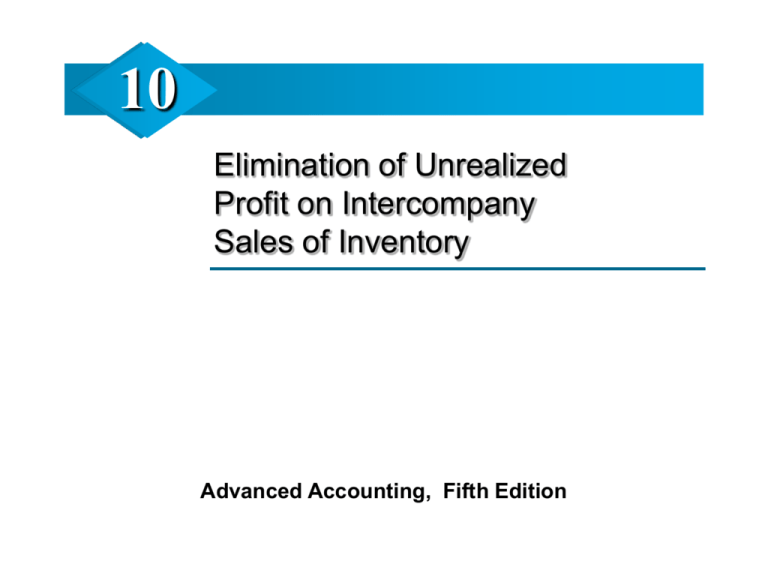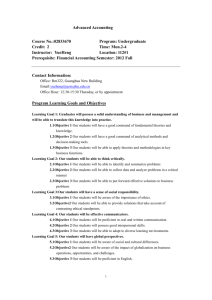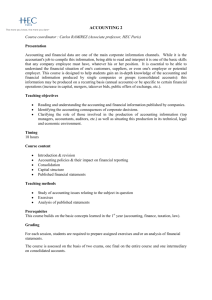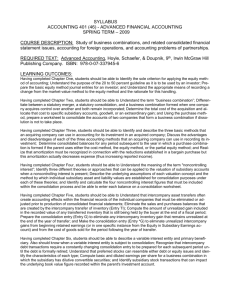
10
Elimination of Unrealized
Profit on Intercompany
Sales of Inventory
Advanced Accounting, Fifth Edition
Learning Objectives
1.
Describe the financial reporting objectives for intercompany sales of
inventory.
2.
Determine the amount of intercompany profit, if any, to be eliminated
from the consolidated statements.
3.
Understand the concept of eliminating 100% of intercompany profit not
realized in transactions with outsiders, and know the authoritative
position.
4.
Distinguish between upstream and downstream sales of inventory.
5.
Compute the noncontrolling interest in consolidated net income for
upstream and downstream sales, when not all the inventory has been sold
to outsiders.
6.
Prepare consolidated workpapers for firms with upstream and
downstream sales using the cost, partial equity, and complete equity
methods.
7.
Discuss the treatment of intercompany profit earned prior to the parent
subsidiary affiliation.
Upstream and Downstream Sales of Inventory
Company P
P sells inventory
Downstream
Company S1
S2 sells inventory
Upstream
S1 sells inventory
Horizontal
Company S2
Consolidated Entity
Profit (loss) that has not been realized through subsequent
sales to third parties is defined as unrealized intercompany
profit (loss) and must be eliminated in the preparation of
consolidated financial statements.
LO 4 Upstream and downstream sales.
Effects of Intercompany Sales of Merchandise on
the Determination of Consolidated Balances
The financial reporting objectives are:
Consolidated sales include only sales with parties outside
the affiliated group.
Consolidated cost of sales includes only the cost to the
affiliated group of goods that have been sold to parties
outside the affiliated group.
Consolidated inventory on the balance sheet is recorded at
its cost to the affiliated group.
Objective is to eliminate the effects of intercompany sales as if they
had never occurred.
LO 1 Financial reporting objectives for intercompany sales.
Intercompany Sales of Merchandise
Downstream
Sales
Determination of Consolidated Sales, Cost of Sales,
and Inventory Balances Assuming Downstream Sales
E6-7: (Downstream Sales-variation) Perkins Company owns
85% of Sheraton Company. Perkins Company sells merchandise to
Sheraton Company at 20% above cost. During 2011 and 2012,
such sales amounted to $450,000 and $486,000, respectively.
At the end of each year, Sheraton Company had sold all of
inventory purchased from Perkins to third parties.
Required: Prepare the workpaper entries necessary to eliminate
the effects of the intercompany sales for 2011.
LO 6 Consolidated workpapers for downstream sales.
Intercompany Sales of Merchandise
Downstream
Sales
E6-7: Summary of 2011 Intercompany Sales
Intercompany Sales
Intercompany COGS
Gross profit
$
$
Total
450,000
375,000
75,000
(COGS)
Resold
$
450,000
375,000
$
75,000
(Inventory)
On Hand
$
$
-
1. The “Total” column represents the Sales and COGS booked by
Perkins to record the sale to Sheraton. The Sales amount also
represents the cost of the inventory recorded by Sheraton.
2. The “Resold” column represents intercompany inventory that was
resold to third parties. Portions resold are recorded in COGS.
3. “On Hand” represents intercompany inventory still on hand in the
affiliated group.
LO 6 Consolidated workpapers for downstream sales.
Downstream
Sales
Intercompany Sales of Merchandise
E6-7: Summary of 2011 Intercompany Sales
Intercompany Sales
Intercompany COGS
Gross profit
$
$
Total
450,000
375,000
75,000
(COGS)
Resold
$
450,000
375,000
$
75,000
(Inventory)
On Hand
$
$
-
Prepare the workpaper entry to eliminate intercompany
sales for 2011.
Sales
Cost of Goods Sold (Purchases)
450,000
450,000
To eliminate intercompany sales of merchandise
LO 6 Consolidated workpapers for downstream sales.
Intercompany Sales of Merchandise
Downstream
Sales
Determination of Consolidated Sales, Cost of Sales,
and Inventory Balances Assuming Downstream Sales
E6-7: (Downstream Sales) Perkins Company owns 85% of
Sheraton Company. Perkins Company sells merchandise to
Sheraton Company at 20% above cost. During 2011 and 2012,
such sales amounted to $450,000 and $486,000, respectively.
At the end of each year, Sheraton Company had in its inventory
one-third of the amount of goods purchased from Perkins during
that year.
Required: Prepare the workpaper entries necessary to eliminate
the effects of the intercompany sales for 2011 and 2012.
LO 6 Consolidated workpapers for downstream sales.
Intercompany Sales of Merchandise
Downstream
Sales
E6-7: Summary of 2011 Intercompany Sales
2011
Intercompany Sales
Intercompany COGS
Gross profit
$
$
Total
450,000
375,000
75,000
(COGS)
Resold
$
300,000
250,000
$
50,000
(Inventory)
On Hand
$
150,000
125,000
$
25,000
Prepare the workpaper entry to eliminate intercompany sales
for 2011.
Sales
Cost of Goods Sold (purchases)
Cost of Goods Sold (ending inventory)
Inventory
450,000
450,000
25,000
25,000
To eliminate intercompany sales and defer unrealized profit
LO 6 Consolidated workpapers for downstream sales.
Intercompany Sales of Merchandise
E6-7:
Alternate
View
2011
Intercompany Sales
Intercompany COGS
Gross profit
$
$
Total
450,000
375,000
75,000
(COGS)
Resold
$
300,000
250,000
$
50,000
Downstream
Sales
(Inventory)
On Hand
$
150,000
125,000
$
25,000
Workpaper entry to eliminate intercompany sales for 2011.
Sales 1
Cost of Goods Sold 1
Cost of Goods Sold 2
Inventory 3
450,000
375,000
50,000
25,000
1.
2.
Original Sales and COGS recorded by Perkins (parent) is reversed.
COGS overstated by Sheraton on resale of goods to third parties.
3.
Inventory on hand is overstated on Sheraton’s books by $25,000 unrealized profit.
LO 6 Consolidated workpapers for downstream sales.
Downstream
Sales
Intercompany Sales of Merchandise
E6-7: Prepare the workpaper entry to eliminate intercompany
sales for 2012.
2011 Unrealized Profit in Inventory
Total
Intercompany Sales
Intercompany COGS
Gross profit
(COGS)
Resold
$
150,000
125,000
$
25,000
Cost or Partial Equity Method *
Retained earnings
Cost of Goods Sold (beg. inventory)
(Inventory)
On Hand
25,000
25,000
To realize the gross profit in inventory deferred in the prior period.
* If the complete equity method is used, the debit is to the Investment account.
LO 6 Consolidated workpapers for downstream sales.
Intercompany Sales of Merchandise
Downstream
Sales
E6-7: Prepare the workpaper entry to eliminate intercompany
sales for 2012.
2012 Intercompany Sales
Intercompany Sales
Intercompany COGS
Gross profit
$
$
Total
486,000
405,000
81,000
(COGS)
Resold
$
324,000
270,000
$
54,000
Sales
Cost of Goods Sold (purchases)
Cost of Goods Sold (ending inventory)
Inventory
(Inventory)
On Hand
$
162,000
135,000
$
27,000
486,000
486,000
27,000
27,000
To eliminate intercompany sales and defer unrealized profit
LO 6 Consolidated workpapers for downstream sales.
Intercompany Sales of Merchandise
Determination of Amount of Intercompany Profit
Gross profit may be stated either as a percentage of sales or
as a percentage of cost. When stated as a percentage of
cost, it is referred to as “markup”.
Inventory Pricing Adjustments
The amount of intercompany profit subject to elimination
should be reduced to the extent that the related goods have
been written down by the purchasing affiliate.
LO 2 Determining the amount of intercompany profit.
Intercompany Sales of Merchandise
Determination of Proportion of Intercompany Profit
to Be Eliminated
“The amount of intercompany profit or loss to be
eliminated . . . is not affected by the existence of a minority
[noncontrolling] interest.
The complete elimination of the intercompany profit or loss is
consistent with the underlying assumption that consolidated
statements represent the financial position and operating
results of a single business enterprise.” [FASB ASC paragraph
810-10-45-18]
LO 3 Eliminating 100% of intercompany profit.
Cost Method: Consolidated Statements
Workpaper—Upstream Sales
Determination of the Noncontrolling Interest in
Combined Income—Upstream or Horizontal Sales
Modification of the calculation of the noncontrolling interest
is applicable only when the subsidiary is the selling affiliate
(upstream or horizontal sales).
Where the parent company is the selling affiliate
(downstream sale), no adjustment is necessary in the
calculation of the noncontrolling interest in consolidated net
income.
LO 5 Noncontrolling interest (NCI) for upstream sales.
Cost Method: Consolidated Workpaper
Upstream
Sales
P6-7: Paque Corporation owns 90% of the common stock of
Segal Company. The stock was purchased for $810,000 on
January 1, 2009, when Segal Company’s retained earnings were
$150,000.
The January 1, 2013, inventory of Paque Corporation includes
$45,000 of profit recorded by Segal Company on 2012 sales.
During 2013, Segal Company made intercompany sales of
$300,000 with a markup of 20% of selling price. The ending
inventory of Paque Corporation includes goods purchased in
2013 from Segal Company for $75,000.
Required: Prepare the worksheet entries and the consolidated
statements workpaper for the year ended December 31, 2013.
LO 6 Consolidated workpapers for upstream Sales- Cost Method.
Upstream
Sales
Cost Method: Consolidated Workpaper
P6-7: Prepare the worksheet entries for Dec. 31, 2013.
Acquisition date retained earnings - Segal
Retained earnings 1/1/13 - Segal
Increase
Ownership percentage
1. Investment in Segal
$ 150,000
180,000
30,000
90%
$ 27,000
27,000
Beg. Retained Earnings - Pague Co.
27,000
To establish reciprocity/convert to equity as of 1/1/2013.
LO 6 Consolidated workpapers for upstream Sales- Cost Method.
Upstream
Sales
Cost Method: Consolidated Workpaper
P6-7: Prepare the worksheet entries for Dec. 31, 2013.
2013 Intercompany Sales
Intercompany Sales
Intercompany COGS
Gross profit
$
$
(COGS)
(Inventory)
Total
Resold
On Hand
300,000 $
225,000 $
75,000
240,000
180,000
60,000
60,000 $
45,000 $
15,000
2. Sales
Cost of Goods Sold (purchases)
3. Cost of Good Sold (ending inventory)
Inventory
300,000
300,000
15,000
15,000
To eliminate intercompany sales and defer unrealized profit
LO 6 Consolidated workpapers for upstream Sales- Cost Method.
Cost Method: Consolidated Workpaper
Upstream
Sales
P6-7: Prepare the worksheet entries for Dec. 31, 2013.
2012 Unrealized Profit in Inventory
(COGS)
Resold
Total
Intercompany Sales
Intercompany COGS
Gross profit
$
(Inventory)
On Hand
45,000
4. Retained Earnings ($45,000 x 90%)
Noncontrolling Interest ($45,000 x 10%)
Cost of Goods Sold (beg. inventory)
40,500
4,500
45,000
To realize the gross profit in inventory deferred in the prior period.
LO 6 Consolidated workpapers for upstream Sales- Cost Method.
Cost Method: Consolidated Workpaper
Upstream
Sales
P6-7: Prepare the worksheet entries for Dec. 31, 2013.
5. Dividend Income
($60,000 x 90%)
54,000
Dividends Declared
54,000
To eliminate intercompany dividends
6. Beg. Retained Earnings - Segal
Common Stock - Segal
180,000
750,000
Investment in Segal
Noncontrolling Interest
837,000
93,000
To eliminate investment account and create NCI account
LO 6 Consolidated workpapers for upstream Sales- Cost Method.
Upstream
Sales
Cost Method: Consolidated Workpaper
P6-7:
Income Statement
Sales
Dividend income
Total revenue
Cost of goods sold
Paque
$ 1,650,000
54,000
1,704,000
1,290,000
Other expenses
Total cost and expense
Net income
Noncontrolling interest
Net income
Segal
$ 795,000
795,000
517,500
310,500
1,600,500
103,500
$
Retained Earnings Statement
Retained earnings, 1/1
Paque
Segal
Net income
Dividends declared
Retained earnings, 12/31
$
103,500
811,500
Eliminations
Debit
Credit
(2)
300,000
54,000 (5)
15,000
(3)
300,000
45,000
NCI
(2)
Consolidated
Balances
$
2,145,000
2,145,000
1,477,500
(4)
206,250
723,750
71,250
$
71,250
$ 369,000
40,500
180,000
369,000
180,000
103,500
71,250
(150,000)
(60,000)
765,000 $ 191,250 $ 589,500
$ 345,000
(4)
27,000
$
$
516,750
1,994,250
150,750
(10,125)
140,625
10,125
(6,000)
4,125 $
798,000
140,625
(150,000)
788,625
10,125
10,125
(1)
(6)
345,000
54,000
$ 426,000
(5)
$
NCI in Consolidated Income = 10% ($71,250 + $45,000 – $15,000) = $10,125
LO 6 Consolidated workpapers for upstream Sales- Cost Method.
Upstream
Sales
Cost Method: Consolidated Workpaper
P6-7:
Balance Sheet
Cash
Accounts receivable
Inventory
Investment in Segal
Other assets
Total assets
Paque
93,000
$
319,500
210,000
810,000
750,000
$ 2,182,500
$
Accounts payable
Other current liabilities
Common stock
Retained earnings
NCI in net assets
Total liab. & equity $
105,000
112,500
1,200,000
765,000
2,182,500
$
$
$
$
Eliminations
Credit
Debit
Segal
75,000
168,750
172,500
27,000
(1)
750,000
589,500
4,500
(6)
15,000
837,000
NCI
(3)
(6)
630,000
1,046,250
45,000
60,000
750,000
191,250
1,046,250
$
1,371,000
(4)
426,000
93,000
$ 1,371,000
(6)
4,125
88,500
92,625
Consolidated
Balances
168,000
$
488,250
367,500
1,380,000
2,403,750
$
150,000
$
172,500
1,200,000
788,625
$
92,625
2,403,750
LO 6 Consolidated workpapers for upstream Sales- Cost Method.
Cost Method—Analysis of Consolidated Net
Income and Consolidated Retained Earnings
Consolidated Net Income
Consolidated net income is the parent company’s income from
its independent operations that has been realized in
transactions with third parties
plus (minus) subsidiary income (loss) that has been
realized in transactions with third parties
plus or minus adjustments for the period relating to the
depreciation, amortization, and impairment of
differences between implied and book values.
LO 6 Consolidated workpapers for upstream Sales- Cost Method.
Cost Method: Consolidated Net Income
Upstream
Sales
P6-7: Prepare a calculation of Paque’s share of Segal’s income.
Reported income of Segal
$ 71,250
Less: amortization of difference between
implied and book value
Less: unrealized profit on 2013 sales to Paque
Plus: profit on prior year's sales to Paque realized
in transactions with third parties in 2013
0
(15,000)
45,000
Subsidiary income included in consolidated income
$ 101,250
Paque's share of Segal’s income ($101,250 x 90%)
$ 91,125
NCI share of Segal’s income ($101,250 x 10%)
Subsidiary income included in consolidated income
10,125
$ 101,250
LO 6 Consolidated workpapers for upstream Sales- Cost Method.
Cost Method: Consolidated Net Income
Upstream
Sales
P6-7: Prepare a calculation of CI in Consolidated Income.
Paque's net income
$103,500
Less: subsidiary dividend income
(54,000)
Paque's net income from its independent operations
49,500
Less: unrealized profit on 2013 sales to Segal
0
Plus: profit on prior year's sales to Segal realized
in transactions with third parties in 2013
0
Paque's income from independent operations that
has been realized in transactions with third parties
Paque's share of Segal’s income (previous slide)
Controlling interest in Consolidated net income
49,500
91,125
$140,625
LO 6 Consolidated workpapers for upstream Sales- Cost Method.
Cost Method—Analysis of Consolidated Net
Income and Consolidated Retained Earnings
Consolidated Retained Earnings
Consolidated Consolidated retained earnings is the parent’s cost
basis retained earnings that has been realized in transactions
with third parties
plus (minus) the parent’s share of the increase (decrease) in
subsidiary retained earnings that has been realized in
transactions with third parties from the date of acquisition to
the current date
plus (minus) the cumulative effect of adjustments to date
relating to the amortization, depreciation, and impairment of
differences between implied and book values.
LO 6 Consolidated workpapers for upstream Sales- Cost Method.
Consolidated Statements Workpaper —
Partial Equity Method
Reminder:
The balances reported by the parent company in income,
retained earnings, and the investment account differ
depending on the method used by the parent company to
record its investment.
However, the method used by the parent company to
record its investment has no effect on the consolidated
balances.
LO 6 Consolidated workpapers – partial equity method.
Partial Equity Method: Workpaper
Upstream
Sales
P6-13: (Note: This is the same problem as Problem 6-7, but
assuming the use of the partial equity method.)
Paque Corporation owns 90% of the common stock of Segal
Company. The stock was purchased for $810,000 on January 1,
2009, when Segal Company’s retained earnings were $150,000.
The January 1, 2013, inventory of Paque Corporation includes
$45,000 of profit recorded by Segal Company on 2012 sales.
During 2013, Segal Company made intercompany sales of $300,000
with a markup of 20% of selling price. The ending inventory of
Paque Corporation includes goods purchased in 2013 from Segal
Company for $75,000. Paque Corporation uses the partial equity
method to record its investment in Segal Company.
LO 6 Consolidated workpapers – partial equity method.
Upstream
Sales
Partial Equity Method: Workpaper
P6-13: Prepare the worksheet entries for Dec. 31, 2013.
1. Equity in Subsidiary Income
64,125
Investment in Segal Company
Dividends declared ($60,000
x 90%)
10,125
54,000
To reverse the effect of parent entries for subsidiary
dividends and income
LO 6 Consolidated workpapers – partial equity method.
Upstream
Sales
Partial Equity Method: Workpaper
P6-13: Prepare the worksheet entries for Dec. 31, 2013.
2013 Intercompany Sales
Intercompany Sales
Intercompany COGS
Gross profit
$
$
(COGS)
(Inventory)
Total
Resold
On Hand
300,000 $
225,000 $
75,000
240,000
180,000
60,000
60,000 $
45,000 $
15,000
2. Sales
Cost of Goods Sold (purchases)
3. Cost of Goods Sold (end. inventory)
Inventory
300,000
300,000
15,000
15,000
To eliminate intercompany sales and defer unrealized profit
LO 6 Consolidated workpapers – partial equity method.
Upstream
Sales
Partial Equity Method: Workpaper
P6-13: Prepare the worksheet entries for Dec. 31, 2013.
2012 Unrealized Profit in Inventory
(COGS)
Resold
Total
Intercompany Sales
Intercompany COGS
Gross profit
$
(Inventory)
On Hand
45,000
4. Retained Earnings ($45,000 x 90%)
Noncontrolling Interest ($45,000 x 10%)
Cost of Goods Sold (beg. inventory)
40,500
4,500
45,000
To realize the gross profit in inventory deferred in the prior period.
LO 6 Consolidated workpapers – partial equity method.
Partial Equity Method: Workpaper
Upstream
Sales
P6-13: Prepare the worksheet entries for Dec. 31, 2013.
5. Beg. Retained Earnings - Segal
Common Stock - Segal
180,000
750,000
Investment in Segal
Noncontrolling Interest
837,000
93,000
To eliminate investment account and create NCI account
LO 6 Consolidated workpapers – partial equity method.
Upstream
Sales
Partial Equity Method: Workpaper
P6-13:
Income Statement
Sales
Equity in Segal income
Total revenue
Cost of goods sold
Other expenses
Total cost and expense
Net income
Noncontrolling interest
Net income
Paque
$ 1,650,000
64,125
1,714,125
1,290,000
Segal
$ 795,000
795,000
517,500
310,500
1,600,500
113,625
$
Retained Earnings Statement
Retained earnings, 1/1
Paque
Segal
Net income
Dividends declared
Retained earnings, 12/31
$
113,625
838,500
Eliminations
Debit
Credit
(2)
300,000
64,125 (1)
15,000
(3)
300,000
45,000
NCI
(2)
Consolidated
Balances
$
2,145,000
2,145,000
1,477,500
(4)
206,250
723,750
71,250
$
71,250
$ 379,125
40,500
180,000
379,125
180,000
113,625
71,250
(150,000)
(60,000)
802,125 $ 191,250 $ 599,625
$ 345,000
$
$
516,750
1,994,250
150,750
(10,125)
140,625
10,125
(6,000)
4,125 $
798,000
140,625
(150,000)
788,625
10,125
10,125
(4)
(5)
345,000
54,000
$ 399,000
(1)
$
NCI in Consolidated Income = 10% ($71,250 + $45,000 – $15,000) = $10,125
LO 6 Consolidated workpapers – partial equity method.
Upstream
Sales
Partial Equity Method: Workpaper
P6-13:
Balance Sheet
Cash
Accounts receivable
Inventory
Investment in Segal
Other assets
Total assets
Paque
93,000
$
319,500
210,000
847,125
$
$
Accounts payable
Other current liabilities
Common stock
Retained earnings
NCI in net assets
Total liab. & equity $
750,000
2,219,625
105,000
112,500
1,200,000
802,125
2,219,625
$
$
$
$
Eliminations
Credit
Debit
Segal
75,000
168,750
172,500
15,000
837,000
10,125
NCI
(3)
(5)
(1)
630,000
1,046,250
$
$
45,000
60,000
750,000
191,250
1,046,250
Consolidated
Balances
168,000
$
488,250
367,500
-
750,000
599,625
4,500
$
1,354,125
(5)
(4)
399,000
93,000
$ 1,354,125
(5)
4,125
88,500
92,625
$
1,380,000
2,403,750
150,000
172,500
1,200,000
788,625
92,625
2,403,750
LO 6 Consolidated workpapers – partial equity method.
Partial Equity Method—Analysis of Consolidated
Net Income and Consolidated Retained Earnings
Consolidated Net Income
Same as Cost Method
Consolidated net income is the parent’s income from its
independent operations that has been realized in
transactions with third parties
plus (minus) subsidiary income (loss) that has been
realized in transactions with third parties
plus or minus adjustments for the period relating to the
depreciation, amortization, and impairment of
differences between implied and book values.
LO 6 Consolidated workpapers – partial equity method.
Partial Equity Method—Analysis of Consolidated
Net Income and Consolidated Retained Earnings
Consolidated Retained Earnings
When the parent uses the partial equity method, the parent’s
share of subsidiary income since acquisition is already included
in the parent’s reported retained earnings.
Consequently, consolidated retained earnings is calculated as
the parent’s recorded partial equity basis retained earnings that
has been realized in transactions with third parties plus or
minus the cumulative effect of the adjustments to date relating
to the depreciation, amortization, and impairment of
differences between implied and book values.
LO 6 Consolidated workpapers – partial equity method.
Consolidated Retained Earnings
Partial
Equity
P6-13: Calculate consolidated retained earnings on Dec. 31,
2013.
Paque's Retained Earnings on 12/31/13
$ 802,125
Unrealized profit on downstream sales
0
Unrealized profit on upstream sales ($15,000 x 90%)
Consolidated retained earnings on 12/31/2013
(13,500)
$ 788,625
LO 6 Consolidated workpapers – partial equity method.
Complete Equity Method: Workpaper
Upstream
Sales
P6-17: (Note: This is the same problem as Problem 6-7 and 6-13,
but assuming the use of the complete equity method.)
Paque Corporation owns 90% of the common stock of Segal
Company. The stock was purchased for $810,000 on January 1,
2009, when Segal Company’s retained earnings were $150,000.
The January 1, 2013, inventory of Paque Corporation includes
$45,000 of profit recorded by Segal Company on 2012 sales.
During 2013, Segal Company made intercompany sales of $300,000
with a markup of 20% of selling price. The ending inventory of
Paque Corporation includes goods purchased in 2013 from Segal
Company for $75,000. Paque Corporation uses the complete equity
method to record its investment in Segal Company.
LO 6 Consolidated workpapers – complete equity method.
Complete Equity Method: Workpaper
Upstream
Sales
P6-17: Prepare the worksheet entries for Dec. 31, 2013.
1. Equity in Subsidiary Income
91,125
Investment in Segal Company
37,125
Dividends declared ($60,000 x 90%)
54,000
To reverse the effect of parent company entries
for subsidiary dividends and income
LO 6 Consolidated workpapers – complete equity method.
Upstream
Sales
Complete Equity Method: Workpaper
P6-17: Prepare the worksheet entries for Dec. 31, 2013.
2013 Intercompany Sales
Intercompany Sales
Intercompany COGS
Gross profit
$
$
(COGS)
(Inventory)
Total
Resold
On Hand
300,000 $
225,000 $
75,000
240,000
180,000
60,000
60,000 $
45,000 $
15,000
2. Sales
Cost of Goods Sold (purchases)
3. Cost of Goods Sold (end. inventory)
Inventory
300,000
300,000
15,000
15,000
To eliminate intercompany sales and defer unrealized profit
LO 6 Consolidated workpapers – complete equity method.
Upstream
Sales
Complete Equity Method: Workpaper
P6-17: Prepare the worksheet entries for Dec. 31, 2013.
2012 Unrealized Profit in Inventory
(COGS)
Resold
Total
Intercompany Sales
Intercompany COGS
Gross profit
$
(Inventory)
On Hand
45,000
4. Retained earnings ($45,000 x 90%)
Noncontrolling Interest ($45,000 x 10%)
Cost of Goods Sold (beg. inventory)
40,500
4,500
45,000
To realize the gross profit in inventory deferred in the prior period
LO 6 Consolidated workpapers – complete equity method.
Complete Equity Method: Workpaper
Upstream
Sales
P6-17: Prepare the worksheet entries for Dec. 31, 2013.
5. Beg. Retained Earnings - Segal
Common Stock - Segal
180,000
750,000
Investment in Segal
Noncontrolling Interest
837,000
93,000
To eliminate investment account and create NCI account
LO 6 Consolidated workpapers – complete equity method.
Upstream
Sales
Complete Equity Method: Workpaper
P6-17:
Income Statement
Sales
Equity in Segal income
Total revenue
Cost of goods sold
Other expenses
Total cost and expense
Net income
Noncontrolling interest
Net income
Paque
$ 1,650,000
91,125
1,741,125
1,290,000
Segal
$ 795,000
795,000
517,500
310,500
1,600,500
140,625
$
Retained Earnings Statement
Retained earnings, 1/1
Paque
Segal
Net income
Dividends declared
Retained earnings, 12/31
$
140,625
Eliminations
Debit
Credit
(2)
300,000
91,125 (1)
15,000
(3)
300,000
45,000
NCI
(2)
Consolidated
Balances
$
2,145,000
2,145,000
1,477,500
(4)
206,250
723,750
71,250
$
71,250
$ 406,125
$ 345,000
$
$
516,750
1,994,250
150,750
(10,125)
140,625
10,125
(6,000)
4,125 $
798,000
140,625
(150,000)
788,625
10,125
10,125
798,000
180,000
180,000
140,625
71,250
406,125
(150,000)
(60,000)
788,625 $ 191,250 $ 586,125
(5)
345,000
54,000
$ 399,000
(1)
$
NCI in Consolidated Income = 10% ($71,250 + $45,000 – $15,000) = $10,125
LO 6 Consolidated workpapers – complete equity method.
Upstream
Sales
Complete Equity Method: Workpaper
P6-17:
Balance Sheet
Cash
Accounts receivable
Inventory
Investment in Segal
Other assets
Total assets
Paque
$
93,000
319,500
210,000
833,625
$
Accounts payable
$
Other current liabilities
Common stock
Retained earnings
NCI in net assets
Total liab. & equity $
750,000
2,206,125
105,000
112,500
1,200,000
788,625
2,206,125
$
Eliminations
Debit
Credit
Segal
75,000
168,750
172,500
40,500
$
$
$
(4)
15,000
837,000
37,125
NCI
(3)
(5)
(1)
630,000
1,046,250
$
45,000
60,000
750,000
191,250
1,046,250
Consolidated
Balances
$
168,000
488,250
367,500
-
$
750,000
586,125
4,500
$
1,381,125
(5)
(4)
399,000
93,000
$ 1,381,125
(5)
4,125
88,500
92,625
$
1,380,000
2,403,750
150,000
172,500
1,200,000
788,625
92,625
2,403,750
LO 6 Consolidated workpapers – complete equity method.
Complete Equity Method—Analysis of
Consolidated Net Income and Consolidated
Retained Earnings
Under the complete equity method:
Consolidated net income equals the parent company’s
recorded income.
Consolidated retained earnings equals the parent
company’s recorded retained earnings.
LO 6 Consolidated workpapers – complete equity method.
Summary of Workpaper Entries
To eliminate intercompany sales:
All Methods
Illustration 6-21
Parent Selling (Downstream)
Sales
X
Purchases (Cost of Sales)
X
To eliminate intercompany profit in ending inventory:
All Methods
Ending Inventory (Cost of Sales)
Inventory (Balance Sheet)
X
X
To recognize intercompany profit in beginning inventory
realized during the year:
Cost or Partial
Equity Methods
Beg. Retained Earnings—Parent
Beg. Inventory - Income
X
X
Statement (Cost of Sales)
Complete Equity
Method
Investment in S Company
Beg. Inventory - Income
Statement (Cost of Sales)
X
X
Summary of Workpaper Entries
To eliminate intercompany sales:
All Methods
Illustration 6-21
Subsidiary Selling (Upstream)
Sales
X
Purchases (Cost of Sales)
X
To eliminate intercompany profit in ending inventory:
All Methods
Ending Inventory (Cost of Sales)
Inventory (Balance Sheet)
X
X
To recognize intercompany profit in beginning inventory
realized during the year:
Cost or Partial
Equity Methods
Complete Equity
Method
Beg. Retained Earnings—Parent
NCI in Equity
Cost of Sales (beg. inventory)
X
X
Investment in S Company
NCI in Equity
Cost of Sales (beg. inventory)
X
X
X
X
Intercompany Profit Prior To Parent–
Subsidiary Affiliation
Generally accepted accounting standards are silent as
to the appropriate treatment of unrealized profit on
assets that result from sales between companies prior
to affiliation (preaffiliation profit).
The question is whether preaffiliation profit should be
eliminated in consolidation. In our opinion, workpaper
entries eliminating preaffliation profit are
inappropriate.
LO 7 Intercompany profit prior to affiliation.
Copyright
Copyright © 2012 John Wiley & Sons, Inc. All rights reserved.
Reproduction or translation of this work beyond that permitted
in Section 117 of the 1976 United States Copyright Act without
the express written permission of the copyright owner is
unlawful. Request for further information should be addressed
to the Permissions Department, John Wiley & Sons, Inc. The
purchaser may make back-up copies for his/her own use only
and not for distribution or resale. The Publisher assumes no
responsibility for errors, omissions, or damages, caused by the
use of these programs or from the use of the information
contained herein.






